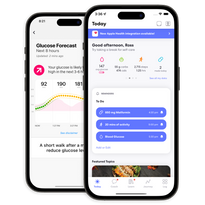Meet Ryan Attar
Ryan Attar has lived with type 1 diabetes for 12 years. He was diagnosed at 27 years-old while overseas serving as a captain in the United States Army.
Discharged immediately following his diagnosis, Ryan has spent the last several years training to become a Naturopathic Physician (ND), and will be opening his own integrative medical clinic in Connecticut in early 2019.
At 39 years old, Ryan has made sure living with type 1 diabetes doesn’t slow him down.
Ryan’s Current Nutrition Plan
“I eat a low-carbohydrate, high-protein diet. I don't exactly call what I do ketogenic, even though I am probably in ketosis quite a bit,” explains Ryan. “I never chase ketone numbers, or worry about being in ketosis, but instead just go for normal, non-diabetic blood sugars (80s and 90s) and a non-diabetic HbA1c.”
Using an at-home A1c kit, Ryan’s last result two weeks ago was 4.8 percent--the result of a very disciplined low-carb diet!

“I generally eat lower in fat than most low-carbers,” adds Ryan. “Always high-protein and always very low-carb. I keep fat generally lower unless I am very active. I do this for no reason other than fat is a very dense calorie source. It’s easy to overdo fat and not stay as lean as I'd like to be.”
He’s also a big fan of The Bernstein Dietand has incorporated a great deal of Bernstein’s nutritional philosophies into his own life with diabetes. (He even shadowed with Dr. Bernstein for three days in his medical practice!)
Check out the One Drop Bernstein Diet guide here!
Ryan’s Current Diabetes Management Plan
He’s not a big fan of insulin pumps. Instead, Ryan uses multiple daily injections with Tresiba insulin for his long-acting insulin needs, and old-fashioned “Regular” insulin for most of his meals since he eats a mostly ketogenic diet that’s high in protein and fats, which are digested slowly. He also keeps rapid-acting Aspart insulin on-hand for correcting high blood sugars and dosing insulin around exercise.
In addition to his glucometer, Ryan wears a Dexcom G5 continuous glucose monitor (CGM).
Exercise Strategies From A Guru
“For the past year, I've been doing Brazilian Jiu-Jitsu a couple times a week. On top of this, I weight train 3-4 times a week, and do 1-2 weekly cardio and conditioning workouts.
Just like managing my blood sugar around new foods -- especially on a low-carb diet where you’re dosing insulin for protein -- managing around exercise involves a lot of trial and error.”

In other words: sometimes things don’t go as smoothly as one might hope. But Ryan takes notes, applies knowledge on diabetes and exercise physiology, and adjusts his plan to get the blood sugar outcome he wants.
“Similar to food, predictability is essential for daily blood sugar management,” he adds. The more you can control the variables around any given exercise or workout session, the more you can predict what it will do to your blood sugar.
Ryan makes it a point to exercise when fasted, meaning exercising either first thing in the morning on an empty stomach with an in-range blood sugar or in the evening before eating dinner (meaning he hasn’t taken any short- or rapid-acting insulin in the 4 to 5 hours since lunch).
Weightlifting Pro-Tip 💡
“When I’m lifting heavy weights, for example, I know I need an insulin bolus before the workout. This compensates for that anaerobic blood sugar spike.
By taking insulin before heavy weight-training, I can keep my blood sugar in the 80s and 90s throughout my workout, and afterward.”
Jiu-Jitsu Pro-Tip 💡
“For jiu-jitsu and cardio workouts, which are both very aerobic, I always monitor my blood sugar closely, and keep pure glucose (dextrose) close by. My blood sugar is normally pretty stable unless I have some insulin on-board from eating or correcting prior to the workout.”
Because Ryan’s diet is so low-carb, the amount of insulin he takes for meals is truly minimal. He has less on-board at any given point in the day compared to someone eating 30 grams of carbs at lunch or 45 grams of carbs at dinner.
“Having so little insulin on-board from eating a low-carb diet means my blood sugar simply doesn’t tank when I start exercising. And if it does start to drop, it’s very minimal and easy to correct with a small amount of fast-acting glucose.”
Morning Workouts vs. Evening Workouts
“There’s not much difference. I usually prefer to workout in the morning when I’m fasted (yep, before eating breakfast), because of how little it impacts my blood sugar.
If I workout in the afternoon or evening, it’s usually been 4-5 hours since lunch; my blood sugar isn’t likely to drop because there aren’t any large boluses of insulin on-board.”
What About Low Blood Sugars During Exercise?
“My weapon of choice to treat lows are Smarties candy. Unlike most candies that use sucrose, Smarties use dextrose, the fastest-acting source of carbs to raise your blood sugar. It’s the same ingredient you’ll find in glucose tablets from pharmacies, but Smarties are much cheaper!
“I get a big bulk-bag of Smarties on Amazon. 1 roll of Smarties is 6 grams of carbs, and the little tablets are easy to divide if I only need 3 or 4 grams of carb to treat a mild low,” explains Ryan, who is diligent about correcting lows without sending his blood sugar up too far.
Traditional diabetes education tells us to treat lows with 15 grams of carbs. But if you treat all lows with that many grams, you’ll find yourself up at 150 mg/dL or higher! Ryan’s aim? To treat lows so that he’s still under 100 mg/dL.
“If you're taking sucrose (think: juice) to treat your low, only half of that sugar molecule is raising your blood sugar (the glucose portion). The other half (fructose) isn't directly raising your blood sugar,” Ryan explains.
“Glucose goes directly to the bloodstream to raise your blood sugar. Fructose does not,” explains Ryan. “Fructose is metabolized in the liver. It won’t directly raise blood glucose.”
“Before running out and using pure fructose to sweeten things to avoid a blood sugar spike, remember: fructose also raises triglycerides and promotes fatty liver.”
“I also don't particularly like Smarties, which works out in my favor. I don't like to think of treating lows as a treat. I like to think of it like a medication, like taking insulin. So I get a precise correction to take me back to normal blood sugar.”
Correcting a High Blood Sugar Before Exercise
“I would personally only adjust this insulin dose for my cardio and jiu-jitsu workout,” explains Ryan. Since cardio and jiu-jitsu are both aerobic, they’ll burn more glucose for fuel, potentially lowering your blood sugar if you have too much insulin on-board.
“For strength training, I would just add the correction dose to my usual pre-strength-training insulin dose. But,” Ryan adds, “I’ve gotten into the habit of always correcting and waiting before exercising or eating.”
What Ryan Wants Everyone To Know About Exercise & Diabetes Management
“Just like with eating, normalizing your blood sugar levels to non-diabetic levels during and after exercise is very possible. Also, just like with food, take good notes for a while about your blood sugars during and after exercising."
"If you’ve gone high or low, take notes of the variables going on during those workouts (cardio vs. strength-training, what you ate, how you dosed for what you ate, etc.), and make adjustments for next time!”




